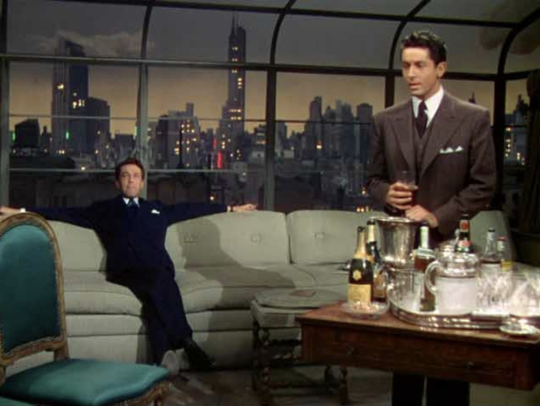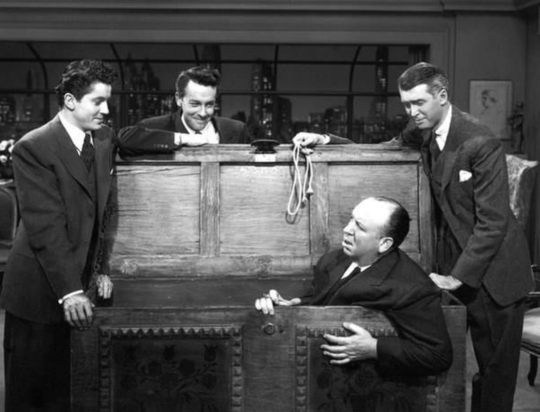
“Rope was an interesting technical experiment that I was lucky and happy to be a part of, but I don’t think it was one of Hitchcock’s better films.” So wrote Farley Granger, one of its two stars, in his memoir Include Me Out. The actor was in his early twenties when the Master of Suspense plucked him from Samuel Goldwyn’s roster. He’d star in the first production from the director’s new Transatlantic Pictures as Phillip Morgan, a pianist and co-conspirator in murder. John Dall would play his partner, homicidal mastermind Brandon Shaw. Granger had the stiff pout to Dall’s trembling smirk.
The “interesting technical experiment” was Hitchcock’s decision to shoot the film, adapted from a twenty-year-old English play, as a series of 10-minute shots stitched together into a simulated feature-length take. This allowed him to retain the stage’s spatial and temporal unities while guiding the audience with the camera’s eye. In the process, he’d embed a host of meta-textual and erotic nuances within the sinister mise-en-scène. Screenwriter Arthur Laurents (Granger’s boyfriend, for a time) updated the play’s fictionalized account of Chicagoan thrill killers Leopold and Loeb to a penthouse in late ‘40s Manhattan. There, Phillip strangles the duo’s friend David—his scream behind a curtain opens the film—immediately prior to a dinner party where they’ll serve pâté atop the box that serves as his coffin. It’s a morbid premise for a comedy of manners, and Brandon taunts his guests throughout the evening. (Asked if it’s someone’s birthday, he coyly replies, “It’s, uh, really almost the opposite.”)

Granger deemed the film lesser Hitchcock due to two limitations. One was the sheer repetition and exact blocking demanded by its formal conceit, the other the Production Code’s blanket ban on “sex perversion,” which meant tiptoeing around the fact that Brandon and Phillip—like their real-life inspirations and, to some degree, Rope’s leading men—were gay. That stringent homophobia forced Hitchcock and Laurents to convey their sexuality through ambiguity and implication; the director would use similar tactics to adapt queer writers like Daphne du Maurier and Patricia Highsmith. (“Hitchcock confessed that he actually enjoyed his negotiations with [Code honcho Joseph] Breen,” notes Thomas Doherty in the book Hollywood’s Censor. “The spirited give-and-take, said Hitchcock, possessed all the thrill of competitive horse trading.”) The nature of the characters’ relationship is hardly subtext: Rope starts with their orgasmic shudder over David’s death, then labored panting after which Brandon pulls out a cigarette and lets in some light. A few minutes later, Brandon strokes the neck of a champagne bottle; Phillip asks how he felt during the act, and he gasps “tremendously exhilarated.”
Like Brandon’s hints about the murder, the homosexuality on display is surprisingly explicit if an audience can decode it. The whole film pivots around their partnership, both criminal and domestic. In an impish bit of conflation, their scheme even stands in for “the love that dare not speak its name,” with David’s body acting as a fetish object in a sexual game no one else can perceive. The guests, as Brandon puts it, are “a dull crew,” “those idiots” who include David’s father and aunt, played by London theater veterans Cedric Hardwicke and Constance Collier. Joan Chandler and Douglas Dick, both a couple years into what would be modest careers, play David’s fiancée Janet and her ex Kenneth. Character actress Edith Evanson appears as housekeeper Mrs. Wilson, a prototype for Thelma Ritter’s Stella in Rear Window, and a top-billed James Stewart is Rupert Cadell, who once mentored the murderers in arcane philosophy.

This was the first of Stewart’s four collaborations with Hitchcock. It cast the actor against type not as a romantic hero but as an observer and provocateur, his gaze shrewd, his dialogue heavy with irony. The role presaged his work in the ‘50s, with Mann rather than Capra, emphasizing psychology over ideology. Rupert, like L.B. Jeffries or Scottie Ferguson, is rooting out a crime, and in so doing comes to seem more loathsome than the villains themselves. “Murder is—or should be—an art,” he lectures midway through Rope, eyebrow arched, martini glass in hand. “Not one of the seven lively perhaps, but an art nevertheless.” Half an hour in real time later, having seen David’s body, he flies into a moralizing monologue: “You’ve given my words a meaning that I never dreamed of!” It takes up the last several minutes of the film, with Rupert snarling from deep in his righteous indignation, “Did you think you were God, Brandon?”
Stewart was a master of sputtering, impassioned oratory, and his facility for it renders Rupert’s hypocrisy especially stark. He taught these murderers; he can’t just shrug off his culpability. The Code decreed that “the sympathy of the audience shall never be thrown to the side of crime, wrongdoing, or sin.” Every transgression reaps a punishment. The ending of Rope abides by the letter of this law, as Rupert fires several shots into the night, drawing a police siren toward the building. He sits, deflated, while Phillip plays piano and Brandon has one last drink. But none of David’s loved ones get to excoriate his killers. The one man here with no integrity, no moral authority, is the one who gets the final, self-flagellating word.

The Code forbade throwing sympathy to the side of sin, but if Hitchcock meant any character in Rope as his stand-in, it was Brandon, not Rupert. The top to Phillip’s bottom, he’s the director of the play within a film. He’s storyboarded it to perfection. Janet, realizing he’s toying with her, cries that he’s incapable of just throwing a party. “No, you’d have to add something that appealed to your warped sense of humor!” Hitchcock, who’d built a corpus of corpses, must have gotten a chuckle from that line. Whereas Phillip fears discovery, Brandon puts symbolism above pragmatism, prioritizing what Phillip dubs his “neat little touches.” He needs to have dinner on the chest, the murder weapon tied around antique books, and his surrogate father Rupert in attendance, much as the film’s director needed to shoot in long takes—not because it’s pragmatic, but because it’s beautiful. He went to great lengths for verisimilar beauty here, as Steven Jacobs details in The Wrong House: The Architecture of Alfred Hitchcock. Miniatures in the three-dimensional cyclorama seen through the broad penthouse window were wired and connected to a ‘light organ’ that allowed for the gradual activation of the skyline’s thousands of lights and hundreds of neon signs. Meanwhile, spun-glass clouds were shifted by technicians from right to left during moments when the camera turned away from the window.
Jacobs notes as well that a painting by Fidelio Ponce de León hanging on Brandon and Phillip’s wall actually belonged to the director and had previously hung in his own home. Rope is avant-garde art wrapped in a bourgeois thriller, about avant-garde art wrapped in a dinner party, pushing moral and aesthetic boundaries while collapsing any distinction between the two. In this nested construction, Brandon the murder artist becomes a figure of auto-critique or perhaps apologia. Did you think you were God, Alfred? By 1948, he’d already made dozens of films, often obliquely about sex and violence, across decades and continents. He’d become the world champion sick joke raconteur. Rope is a reckoning with the ethics of his genre.

By 1948, the world had changed. A few years earlier, Hitchcock’s friend (and Rope co-producer) Sidney Bernstein had asked him to advise on a film about Germany’s newly liberated concentration camps. As Kay Gladstone writes in Holocaust and the Moving Image, Hitchcock worried that “tricky editing” would let skeptics read its footage as fraudulent and asked the editors “to use as far as possible long shots and panning shots with no cuts.” The director took his own counsel to heart.
Rope was also his first color film, the start of his fascination with dull palettes. (A quarter-century later he’d limn Frenzy’s London with every shade of beige.) Genteel browns and grays dominate the penthouse, the hues of men’s suits. Only after nightfall does the apartment glow with, in Jacobs’ phrasing, “the expressive possibilities of urban neon light.” The dinner party takes place at the crest of postwar modernity, a world away from the camps. Here, among the East Coast intelligentsia, murder’s merely a thought experiment. When David’s father mentions Hitler, Brandon dismisses him as “a paranoiac savage.” Yet even in polite society, the evening can begin with a secret killing and end with that iniquity brought to light. “Perhaps what is called civilization is hypocrisy,” says Brandon. “Perhaps,” David’s father concedes.
In 1948, the world was changing. That year saw the publication of Gore Vidal’s landmark gay novel The City and the Pillar and the first of the Kinsey Reports. Antonioni was a documentarian about to make his first feature; Truffaut was a delinquent catching Hitchcock movies at the Cinémathèque. Rope’s amorality and pitch-black humor augur a world and a cinema that were yet to come. It’s thorny gay art through a straight auteur. The film’s last thirty seconds show Rupert’s back to the camera while Brandon sips his cocktail and Phillip plays a tune, the trio lit by flashing neon. In this denouement lie decadence and damnation, art and death, the Code-closeted past and a disaffected future.
